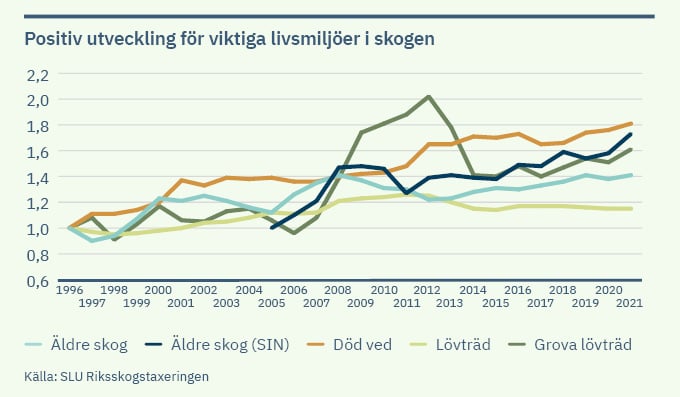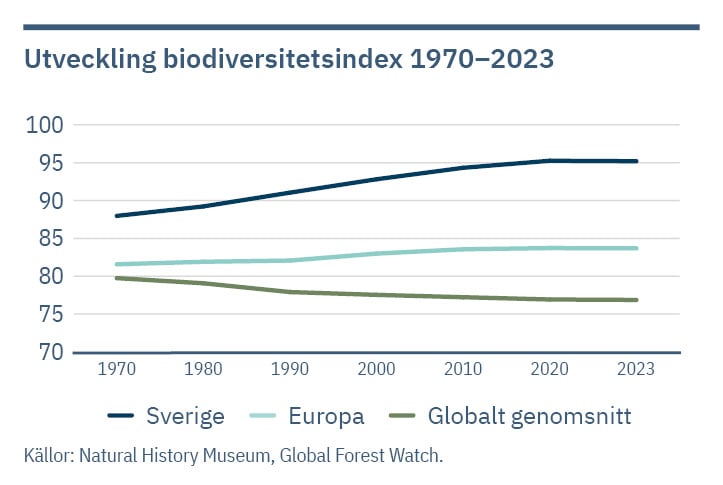Holmen’s Knowledge forests are large areas of forest with high conservation value that we are opening up to gather and share knowledge about forestry, biodiversity and growth.
- Holmen /
- Biodiversity
Biodiversity
Holmen strives for high and profitable growth, while at the same time ensuring that all naturally occurring species can survive in the forest landscape.
Active measures for thriving forests
Sustainably managed forests with healthy ecosystems and rich biodiversity are crucial for the forest to contribute renewable raw materials to the climate transition. Holmen invests around SEK 200 million annually in forest management. All to ensure good growth and viable ecosystems for future generations.
Forest planning is the basis for active and sustainable forestry. Every ten years, we take stock of our forests to ensure sustainable harvest levels and a growing wood supply. The planning includes climate adaptation through risk analyses and action plans.
Just over 20 per cent of Holmen's forest area is used for environmental purposes, including voluntary set-asides, statutory protection and environmental considerations in the managed forest. Local consideration plans govern management to preserve and create natural values.
Holmen's nature conservation work is based on three parts:
Environmental considerations in managed forests
In our active forestry, we take great account of both natural and cultural values and implement several measures to preserve and strengthen biodiversity. High stumps and dead wood are saved to provide habitats for wood-dwelling insects and fungi. Buffer zones along watercourses are preserved to protect aquatic species and improve water quality. When harvesting, buffer zones with trees and shrubs are also left intact to benefit biodiversity. Thick trees, both living and dead, are left behind as important nesting places for birds and insects.
Nature conservation management
As a natural part of our forestry, we also implement measures to develop or strengthen natural values, for example we burn forests and take out growing spruce for the benefit of deciduous trees. Controlled burning is done to create fire-damaged wood, an important habitat for many endangered species. Holmen is also working to restore wetlands and create varied forest landscapes. Holmen carries out nature conservation management on around 400 hectares annually to strengthen biodiversity and contribute to healthy, resilient ecosystems.
Voluntary set-asides
Holmen's forest holdings include both formally protected forest and voluntary set-asides. In formally protected areas, such as nature reserves, natural processes are allowed to unfold without impact, which benefits species that require untouched forest. Holmen has also identified more than 9,000 areas that have been voluntarily set aside or managed with goals other than production as they have large or unique values that should be preserved.
Environmental considerations in managed forests
In our active forestry, we take great account of both natural and cultural values and implement several measures to preserve and strengthen biodiversity. High stumps and dead wood are saved to provide habitats for wood-dwelling insects and fungi. Buffer zones along watercourses are preserved to protect aquatic species and improve water quality. When harvesting, buffer zones with trees and shrubs are also left intact to benefit biodiversity. Thick trees, both living and dead, are left behind as important nesting places for birds and insects.
Nature conservation management
As a natural part of our forestry, we also implement measures to develop or strengthen natural values, for example we burn forests and take out growing spruce for the benefit of deciduous trees. Controlled burning is done to create fire-damaged wood, an important habitat for many endangered species. Holmen is also working to restore wetlands and create varied forest landscapes. Holmen carries out nature conservation management on around 400 hectares annually to strengthen biodiversity and contribute to healthy, resilient ecosystems.
Voluntary set-asides
Holmen's forest holdings include both formally protected forest and voluntary set-asides. In formally protected areas, such as nature reserves, natural processes are allowed to unfold without impact, which benefits species that require untouched forest. Holmen has also identified more than 9,000 areas that have been voluntarily set aside or managed with goals other than production as they have large or unique values that should be preserved.
Read more here:
Biodiversity indicators
Holmen's goal for biodiversity and ecosystems linked to forestry is that all naturally occurring species can thrive in the forest landscape in the long term.
The biodiversity in the forest is affected by several factors. In order to be able to follow the development and evaluate the implemented efforts, Holmen bases its work on inventory data from the National Forest Assessment at SLU. Five indicators have been identified that show how a selection of important habitats in the forest are developing:
To assess biodiversity in the forest, various habitats important for forest-dwelling species are analysed. To monitor developments and evaluate implemented measures, Holmen bases its work on inventory data from the Swedish National Forest Inventory. In collaboration with other forestry companies and authorities, five indicators have been identified to monitor changes in these key habitats over time:
- Area of older forest
- Area of older forest with special indication of natural values (SIN)
- Volume of dead wood
- Volume of deciduous trees
- Volume of large deciduous trees
When selecting indicators, Holmen has taken into account the Swedish Forest Industries' biodiversity goals and conducted stakeholder dialogues.
The ambition for the selected indicators is a positive trend over time. With a production cycle in the forest of almost a hundred years, changes do not occur overnight, but statistics from the independent inventories show that the development over the past 30 years has been positive.

The indicators represent different types of habitats that together provide a picture of the conditions for biodiversity on Holmen's land.
Older forest
Older forests are important in several aspects. Old trees host birds, insects, mosses and lichens while being valuable indicators of unaffected soil and field layers, which benefits ground vegetation and fungi.
Older forest with special indication of nature values
Older forests with a special indication of conservation values not only show the age of the forest, but also whether they have special qualities that create better conditions for more demanding species, for example if an area has really old and coarse trees. dead wood and trees of different ages.
Dead wood
Dead wood is important for biodiversity in a forest and serves as a habitat and food source for birds, insects, fungi, mosses and lichens. It is estimated that about 20 percent of all forest species are dependent on dead wood.
Deciduous and coarse deciduous trees
Deciduous trees and coarse deciduous trees are important for birds and rare insect species, both for food and as nesting trees. Aspen, birch and deciduous trees such as elm, beech, oak and maple have a number of mosses and lichens that only grow on each tree species, and then usually on old and coarse trees.
Older forest
Older forests are important in several aspects. Old trees host birds, insects, mosses and lichens while being valuable indicators of unaffected soil and field layers, which benefits ground vegetation and fungi.
Older forest with special indication of nature values
Older forests with a special indication of conservation values not only show the age of the forest, but also whether they have special qualities that create better conditions for more demanding species, for example if an area has really old and coarse trees. dead wood and trees of different ages.
Dead wood
Dead wood is important for biodiversity in a forest and serves as a habitat and food source for birds, insects, fungi, mosses and lichens. It is estimated that about 20 percent of all forest species are dependent on dead wood.
Deciduous and coarse deciduous trees
Deciduous trees and coarse deciduous trees are important for birds and rare insect species, both for food and as nesting trees. Aspen, birch and deciduous trees such as elm, beech, oak and maple have a number of mosses and lichens that only grow on each tree species, and then usually on old and coarse trees.
Sweden's forests have good conditions for biodiversity
Ahead of the UN Convention on Biological Diversity (COP15), independent researchers from the UK's Natural History Museum developed a biodiversity index that estimates how much of the original number of species and habitats remains.

The Biodiversity Index is based on the world's largest database on how organic communities have been affected by humans and is used to monitor biodiversity in different regions.
The desired level of biodiversity in an area is at least 90 per cent, which is to be regarded as a limit value that the biodiversity in an area should not be below.
Together with Finland, Sweden is the most forested country in Europe, with almost 70 percent forest land and a well-developed forest industry. According to the biodiversity index, Sweden also has good conditions for functioning ecosystems with an index of just over 95 percent. The index also shows that the conditions for biodiversity in Sweden have improved over the past 50 years.
Contact sustainability issues

Stina Sandell
Senior vice President Sustainability and Communications


